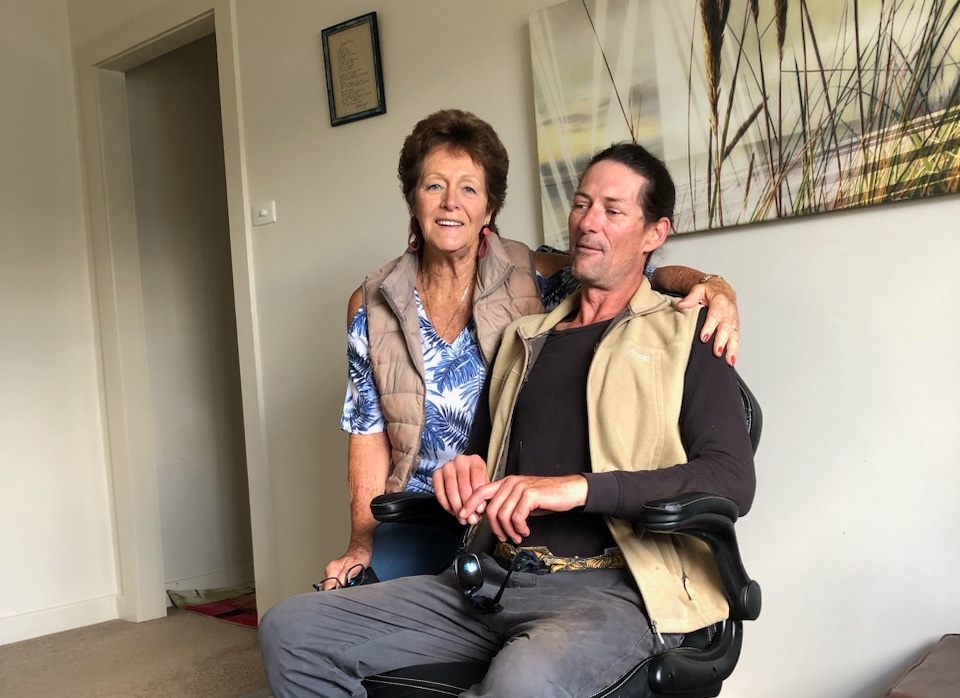Stigma and mental health struggles have led to staggering levels of suicide ideation in people with chronic pain. This National Pain Week (24–30 July) Australian Pharmacist explores how to help patients cope with ongoing pain.
When Dean Conolly was 21, he experienced an L5-S1 tear. Now, 27 years later, he still experiences pain on a daily basis.
Dean’s condition has worsened over time, leading to multilevel degenerative disc disease and stage three modic changes. This caused him to stop working around 10 years ago.
‘I’ve got constant nerve pressure and migraines – life is a misery,’ he said. ‘Over time you learn that to survive, you need to concentrate on surviving. So you inevitably end up alone, withdrawn from your friends and your support network.’
After his injury, Dean was prescribed a daily dose of 250 milligrams of oxycodone, which eventually tapered down to 40 mg. With opioid regulations tightening over the years, Dean was prescribed pregabalin instead, leading to severe stomach bleeding and mental health issues.

Now, Dean relies on medicinal cannabis to alleviate his pain which he sources through doctors and pharmacies in Queensland, and costs $1,000 per month.
At times, when his pain worsens, Dean seeks stronger forms of relief. ‘When I suggest opioid patches, the response is always, “no, I’ll give you anti-inflammatories or Lyrica”,’ he said.
It doesn’t help when Dean explains his prior experiences with pregabalin. ‘By that point, you’re an arguing drug addict and your appointment is over.’
When doctors and pharmacists see a ‘bloke walk in with a crook back and a walking stick’ looking for pain relief, they immediately register it as drug seeking behaviour.
‘Which it is, but the question should then be, are you seeking pain relief for medical purposes?’ he said. ‘It becomes a matter of trust between the patient, doctor and pharmacist. If they’re not going to trust anyone, they can expect the same in return.’
Drastic effects of pain
Dean is not alone in his pervasive chronic pain experience. According to the 2023 National Pain Survey of nearly 3,000 patients living with chronic pain, most experience sleep disturbances (91%) and mental health issues (76%). Over half (53%) have experienced stigma when accessing healthcare, characterised by feeling they are ‘treated as a drug addict’, ‘not listened to’, or ‘like I am imagining my pain’.
Government regulations around opioid prescribing also have an impact. Like Dean, one in five respondents were forced to reduce their opioids. In those that had their opioids substituted with other medicines, anti-depressants and anti-inflammatories were the most common agents used.
These combined factors are driving suicide ideation in almost one in two people living with chronic pain, found the survey.
How can pharmacists help?
As the most accessible healthcare professionals who regularly dispense pain-relief medicines, community pharmacists have a key role in listening to validating people with chronic pain, said Nicolette Ellis MPS, President of Chronic Pain Australia.

This includes discussing their expectations around treatment – whether they are just starting a medicine or they’ve been taking it long term.
‘It’s always good to check if they’re benefiting from the medication and they’re reaching the goals of that therapy.’
Education and screening around adverse effects is also key. ‘With some medicines such as gabapentinoids, the adverse effects can be delayed and appear 3–6 months after initiation,’ said Ms Ellis. ‘Patients might be on a combination of medications, so they’re not sure what’s working or what’s not.’
Reducing stigma around opioid use
A key area of focus in the survey was around enforced opioid tapering, which can lead to worsening pain, particularly if patients have not consented to the process, said Ms Ellis.
‘A lot of pharmacists are asked, “Which GPs will be comfortable seeing me because I have chronic pain and I’m prescribed opioids?”’ she said.
Should pharmacists be approached by a patient seeking referral, this should be a catalyst to initiate a more comprehensive conversation around medicine management and hope they are coping. When opioid tapering is enforced or patents feel abandoned, this can lead to a significant risk of suicidal thoughts or self-harm, said Ms Ellis.
‘We’ve got a lot of skills and knowledge to impart for people with chronic pain,’ she said. ‘That should trigger more services that we can provide as pharmacists instead of simply referring them them to a prescriber or allied health.’
Patients with chronic pain should access the following funded services annually at a minimum, including:
- MedsChecks
- Home Medicines Reviews.
The option to stabilise on an opioid, or other strategies such as opioid rotation should also be considered.
‘We know tolerance is inevitable with opioids. By rotating from one type of opioid to another, it introduces a new molecule to the body, reducing their total morphine equivalent,’ said Ms Ellis. ‘This improves analgesia and can reduce adverse effects or potential harms from the medicine.’
In some instances, tapering might not be a goal of therapy at any point, particularly if the medicines are increasing quality of life and improving functionality.
‘It’s hard to make a blanket statement for how long people should be on opioids when they have chronic pain,’ she said.
‘It doesn’t help when Dean explains his prior experiences with pregabalin. “By that point, you’re an arguing drug addict and your appointment is over”.’
‘I’ve had patients on opioid medications where we have validated the effectiveness and they’ve been stable on those medications for a period of time.’
Remaining active
Another central finding from the survey is the struggle to remain active – 80% of respondents found this challenging.
Pharmacists should emphasise the importance of remaining active to improve the pain experience. For example, if patients present with lower back pain seeking non-prescription (OTC) medicines such as diclofenac.
‘In about 99% of cases, lower back pain is caused by a muscular strain that can last up to 6 weeks in an acute presentation,’ said Ms Ellis. ‘What we commonly see in chronic pain is that when people get acute muscular strains, they have a fear of movement because it increases their pain.’
This can eventually lead to neuroplasticity, where the body increases pain signals as a learned behaviour during movement as a protection mechanism. Along with educating patients about expectations of recovery and timeframes, pharmacists should advise them to:
- engage in relative movement and avoid overdoing it
- apply ice/heat therapies
- use non-prescription anti-inflammatories, creams or paracetamol.
Allied health referrals for patients with chronic pain should be individualised by understanding what approach works for the patient and what doesn’t.
‘Some patients might not want to see a psychologist, whereas others prefer to,’ said Ms Ellis.
Reaching crisis point
Pharmacists should be aware of the high risk of suicide ideation in patients with chronic pain, and ensure the topic is broached in any consultation by:
- asking if patients are having any thoughts or plans
- referring on to acute care services where required.
Another important referral point is Pain Link, a peer-to-peer support phone line staffed by people living with chronic pain.
‘The Australian Pain Management Association also has a number of face-to-face support groups around Australia,’ said Ms Ellis. ‘Sometimes connection with communities is the most validating thing for someone living with chronic pain, so those groups can be a lifesaver.’



 Pharmacists have always prescribed, but they have the potential to prescribe much more
Pharmacists have always prescribed, but they have the potential to prescribe much more



 Sponsorship information
Sponsorship information


 Talking to patients who have questions
Talking to patients who have questions





